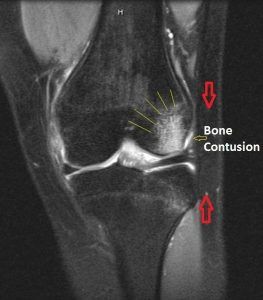
Understanding and how to manage Bone Bruising?
The medical term for bone bruising is a “bony contusion” and this is a result of heavy impact (trauma) to the bone or a bone stress reaction (overuse) where it leads to bone bruising.
There are 2 main types of bone bruises:
- Sub-periosteal haematoma: consists of collection of blood under the periosteal of the bone. This type of injury is due to direct high force/velocity trauma to the bone.
- Interosseous bruising: where there is damage to the bone marrow. This is the blood supply within the bone is damaged and causes internal bleeding. This type is due to repetitive compressive forces on the bone E.g long distance running.
USEFUL LINKS
Who is at risk of bone bruising?
-
- People who run and jump regularly on hard surfaces (e.g basketball, soccer, netball players, long distance runners)
- People who are not conditioned for running or high impact sports/exercise and go from zero to hero very quickly (loading issue for bone and soft tissue).
Note: Bone stress reactions that lead to bone bruising is due to an excessive amount of load going through that part of the bone that is unaccustomed!
Signs and Symptoms of Bone Bruising:
- Localised swelling around the painful area of bone
- Pain and tenderness to touch over the bone
- Joint pain near the impact zone
- Joint stiffness, loss of ROM, decreased muscle strength overtime
- Difficulties weight bearing if in lower limb (e.g hip/knee/ankle)
Treatment of Bone Bruising:
First and foremost is relative rest, ice, compression, elevation. Talking with your health professional about reducing the amount of load going through the affected bone or joint and commencing a strength and conditioning program to build up the strength of the bone and prevent it from occurring in the future.
Note: an x ray or MRI scan may be required to determine the extent of the bone bruising and how long approximately it will take to heal. These scans will only be ordered to rule out a small fracture or if your symptoms are getting worse.
How long for Bone Bruising to recover?
It really depends on your clinical symptoms, but generally bone bruising can resolve from as early as 2 weeks if the appropriate rest and deloading has occurred. If the bruising is more severe without a fracture ,then can take up to 6 weeks+ .
At TPM, our team are experienced in treating bone stress related injuries and developing an individualised rehab program to match your rehab goals.
If you are experiencing these symptoms and would like it assessed by our team at TPM, please feel free to contact The Physio Movement on 1300 TPMFIT or book online via our website www.thephysiomovement.com.au or via facebook.
A blog by our Senior Physiotherapist Jordan.


